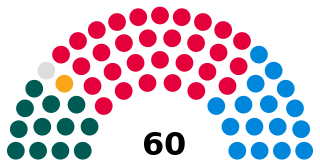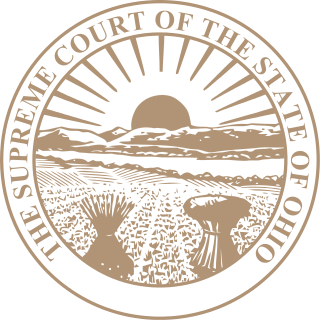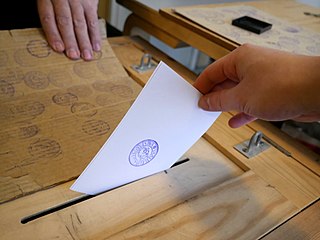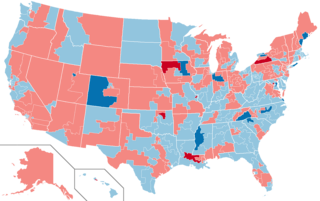A general election is an electoral process to choose most or all members of an elected body, typically a legislature. They are distinct from by-elections, which fill a seat that has become vacant between general elections. In most systems, a general election is a regularly scheduled election, typically including members of a legislature, and sometimes other officers such as a directly elected president. General elections may also take place at the same time as local, state/autonomous region, European Parliament, and other elections, where applicable. For example, on 25 May 2014, Belgian voters elected their national parliament, 21 members of the European Parliament, and regional parliaments.
2024 (MMXXIV) is the current year, and is a leap year starting on Monday of the Gregorian calendar, the 2024th year of the Common Era (CE) and Anno Domini (AD) designations, the 24th year of the 3rd millennium and the 21st century, and the 5th year of the 2020s decade.

A member of the Senedd is a representative elected to the Senedd. There are sixty members, with forty members chosen to represent individual Senedd constituencies, and twenty to represent the five electoral regions of the Senedd in Wales.
The 100 seats in the United States Senate are divided into three classes for the purpose of determining which seats will be up for election in any two-year cycle, with only one class being up for election at a time. With senators being elected to fixed terms of six years, the classes allow about a third of the seats to be up for election in any presidential or midterm election year instead of having all 100 be up for election at the same time every six years. The seats are also divided in such a way that any given state's two senators are in different classes so that each seat's term ends in different years. Class 1 and class 2 consist of 33 seats each, while class 3 consists of 34 seats. Elections for class 1 seats are scheduled to take place in 2024, class 2 in 2026, and the elections for class 3 seats in 2028.

The U.S. state of Ohio has a Supreme Court of seven members, who are elected for six-year terms.

A presidential election is the election of any head of state whose official title is President.
Canada holds elections for legislatures or governments in several jurisdictions: for the federal (national) government, provincial and territorial governments, and municipal governments. Elections are also held for self-governing First Nations and for many other public and private organizations including corporations and trade unions. Municipal elections can also be held for both upper-tier and lower-tier governments.

The 1920 United States Senate elections were elections for the United States Senate that coincided with the presidential election of Warren G. Harding. The 32 seats of Class 3 were contested in regular elections, and special elections were held to fill vacancies. Democrat Woodrow Wilson's unpopularity allowed Republicans to win races across the country, winning ten seats from the Democrats and providing them with an overwhelming 59-to-37 majority. The Republican landslide was so vast that Democrats lost over half of the seats that were contested this year and failed to win a single race outside the South.

The 1986 United States House of Representatives elections was held on November 4, 1986, to elect U.S. Representatives to serve in the 100th United States Congress. They occurred in the middle of President Ronald Reagan's second term in office, while he was still relatively popular with the American public. As in most mid-term elections, the President's party — in this case, the Republican Party — lost seats, with the Democratic Party gaining a net of five seats and cementing its majority. These results were not as dramatic as those in the Senate, where the Republicans lost control of the chamber to the Democrats.

Elections in Portugal are free, fair, and regularly held, in accordance with election law.

Elections in Zambia take place within the framework of a multi-party democracy and a presidential system. The President and National Assembly are simultaneously elected for five-year terms.

Elections in Pennsylvania elect the five state-level offices, the Pennsylvania General Assembly, including the senate and house of representatives, as well as the state's congressional delegation for the United States Senate and the United States House of Representatives. Presidential elections are held every four years in Pennsylvania. The state is one of the most competitive nationally, with narrow victories that alternate between the parties across all major offices. On the presidential level, the state has been considered a swing state throughout its entire history as it only voted for the nationwide loser on only 10 occasions. Meaning it has voted for the national winner 83% of the time, as of 2020.

538, originally rendered as FiveThirtyEight, was an American website that focused on opinion poll analysis, politics, economics, and sports blogging in the United States. Founder Nate Silver left in April of 2023. On September 18, 2023, the original website domain at fivethirtyeight.com was closed and web traffic became redirected to ABC News pages. The logo was replaced, with the name 538 now used instead of FiveThirtyEight.

The 1998 California State Assembly elections were held on November 3, 1998. California's State Assembly in its entirety comes up for election in even numbered years. Each seat has a two-year term and members are limited to three 2-year terms. All 80 biennially elected seats in the Assembly were up for election this year. Democrats retained control of the Assembly, gaining five Republican-held seats in the process.

The election of the president and the vice president of the United States is an indirect election in which citizens of the United States who are registered to vote in one of the fifty U.S. states or in Washington, D.C., cast ballots not directly for those offices, but instead for members of the Electoral College. These electors then cast direct votes, known as electoral votes, for president, and for vice president. The candidate who receives an absolute majority of electoral votes is then elected to that office. If no candidate receives an absolute majority of the votes for president, the House of Representatives elects the president; likewise if no one receives an absolute majority of the votes for vice president, then the Senate elects the vice president.

The 1998 United States elections were held on November 3, 1998, in the middle of Democratic President Bill Clinton's second term and during impeachment proceedings against the president as a result of the Clinton–Lewinsky scandal. Though Republicans retained control of both chambers of Congress, the elections were unusual because this is the first midterm since 1934 that the president's party gained seats in the House of Representatives.

The 1876–77 United States Senate elections were held on various dates in various states, coinciding with Rutherford B. Hayes's narrow election as president. As these U.S. Senate elections were prior to the ratification of the Seventeenth Amendment in 1913, senators were chosen by state legislatures. Senators were elected over a wide range of time throughout 1876 and 1877, and a seat may have been filled months late or remained vacant due to legislative deadlock. In these elections, terms were up for the senators in Class 2.

The 2022 United States elections were held on November 8, 2022, with the exception of absentee balloting. During this U.S. midterm election, which occurred during the term of incumbent president Joe Biden of the Democratic Party, all 435 seats in the U.S. House of Representatives and 35 of the 100 seats in the U.S. Senate were contested to determine the 118th United States Congress. Thirty-nine state and territorial U.S. gubernatorial elections, as well as numerous state and local elections, were also contested. This was the first election affected by the 2022 U.S. redistricting that followed the 2020 U.S. census. The Republican Party ended unified Democratic control of congress and the presidency by winning a majority in the House of Representatives while the Democrats expanded their senate majority.

The 2026 United States Senate elections are scheduled to be held on November 3, 2026, with 33 of the 100 seats in the Senate being contested in regular elections, the winners of which will serve six-year terms in the United States Congress from January 3, 2027, to January 3, 2033. Senators are divided into three groups, or classes, whose terms are staggered so that a different class is elected every two years. Class 2 senators were last elected in 2020, and will be up for election again in 2032.















